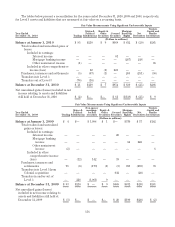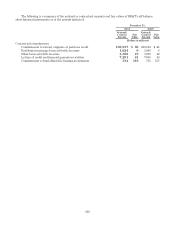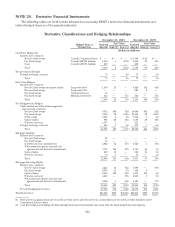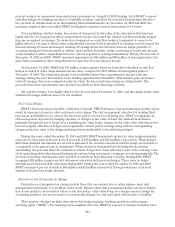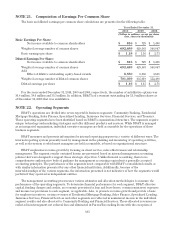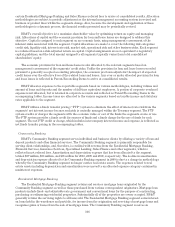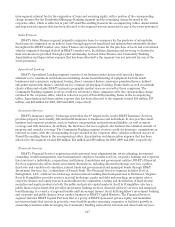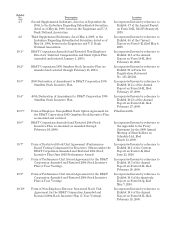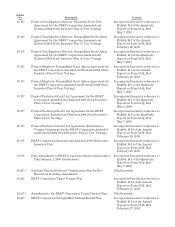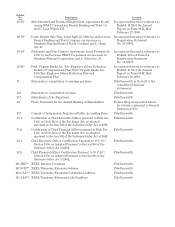BB&T 2010 Annual Report Download - page 166
Download and view the complete annual report
Please find page 166 of the 2010 BB&T annual report below. You can navigate through the pages in the report by either clicking on the pages listed below, or by using the keyword search tool below to find specific information within the annual report.certain Residential Mortgage Banking and Sales Finance referral fees to arrive at consolidated results. Allocation
methodologies are subject to periodic adjustment as the internal management accounting system is revised and
business or product lines within the segments change. Also, because the development and application of these
methodologies is a dynamic process, the financial results presented may be periodically revised.
BB&T’s overall objective is to maximize shareholder value by optimizing return on equity and managing
risk. Allocations of capital and the economic provision for loan and lease losses are designed to address this
objective. Capital is assigned to each segment on an economic basis, using management’s assessment of the
inherent risks associated with the segment. Capital allocations are made to cover the following risk categories:
credit risk, liquidity risk, interest rate risk, market risk, operational risk and other business risks. Each segment
is evaluated based on a risk-adjusted return on capital. Capital assignments are not equivalent to regulatory
capital guidelines, and the total amount assigned to all segments typically varies from total consolidated
shareholders’ equity.
The economic provision for loan and lease losses is also allocated to the relevant segments based on
management’s assessment of the segments’ credit risks. Unlike the provision for loan and lease losses recorded
pursuant to generally accepted accounting principles, the economic provision adjusts for the impact of expected
credit losses over the effective lives of the related loans and leases. Any over or under allocated provision for loan
and lease losses is reflected in Parent/Reconciling Items to arrive at consolidated results.
BB&T allocates expenses to the reportable segments based on various methodologies, including volume and
amount of loans and deposits and the number of full-time equivalent employees. A portion of corporate overhead
expense is not allocated, but is retained in corporate accounts and reflected as Parent/Reconciling Items in the
accompanying tables. Income taxes are allocated to the various segments based on taxable income and statutory
rates applicable to the segment.
BB&T utilizes a funds transfer pricing (“FTP”) system to eliminate the effect of interest rate risk from the
segments’ net interest income because such risk is centrally managed within the Treasury segment. The FTP
system credits or charges the segments with the economic value or cost of the funds the segments create or use.
The FTP system provides a funds credit for sources of funds and a funds charge for the use of funds by each
segment. The net FTP credit or charge, which includes intercompany interest income and expense, is reflected as
net funds transfer pricing in the accompanying tables.
Community Banking
BB&T’s Community Banking segment serves individual and business clients by offering a variety of loan and
deposit products and other financial services. The Community Banking segment is primarily responsible for
serving client relationships, and, therefore, is credited with revenue from the Residential Mortgage Banking,
Financial Services, Insurance Services, Specialized Lending, Sales Finance and other segments, which is
reflected in net referral fees. Amortization and depreciation expense that has been allocated to the segment
totaled $37 million, $38 million, and $81 million for 2010, 2009 and 2008, respectively. The decline in amortization
and depreciation expense allocated to the Community Banking segment in 2009 is due to a change in methodology
whereby the Community Banking segment no longer carries real estate assets. The expenses related to real
estate assets including depreciation and amortization were moved to an allocated expense category contained in
noninterest expenses.
Residential Mortgage Banking
The Residential Mortgage Banking segment retains and services mortgage loans originated by the
Community Banking segment as well as those purchased from various correspondent originators. Mortgage loan
products include fixed- and adjustable-rate government and conventional loans for the purpose of constructing,
purchasing or refinancing residential properties. Substantially all of the properties are owner occupied. BB&T
generally retains the servicing rights to all loans sold. The Residential Mortgage Banking segment earns interest
on loans held in the warehouse and portfolio, fee income from the origination and servicing of mortgage loans and
recognizes gains or losses from the sale of mortgage loans. The Community Banking segment receives an
166


